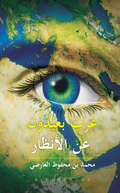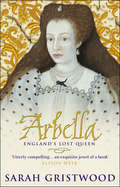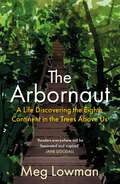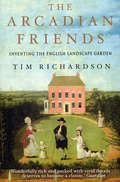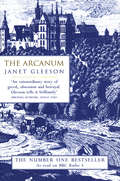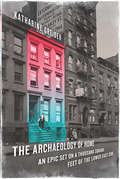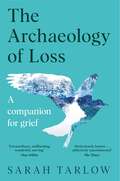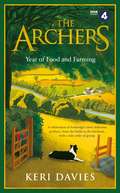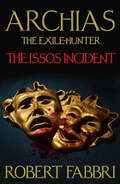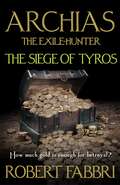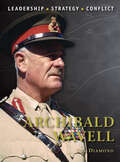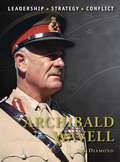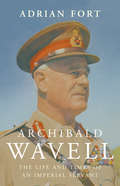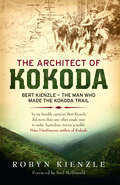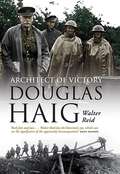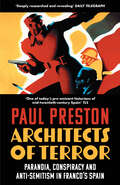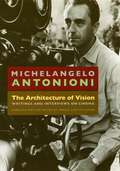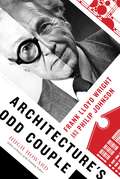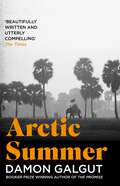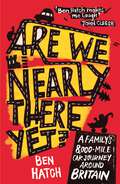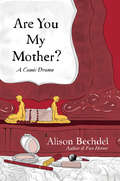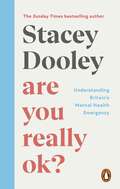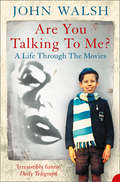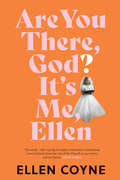- Table View
- List View
Arabs Unseen(Arabic)
by Mohammed Mahfoodh AlardhiArabs Unseen explores the enlightening journeys of 10 exemplary figures from the modern Arab world. It embraces the theme of drawing inspiration from these individuals who overcame various challenges to build a body of work in their respective fields. Their experiences are significant for all generations within the Arab world and beyond.
Arbella: England's Lost Queen
by Sarah Gristwood'It is Arbella they would proclaim Queen if her mistress should happen to die' Sir William Stanley, 1592Niece to Mary, Queen of Scots, granddaughter to the great Tudor dynast Bess of Hardwick, Lady Arbella Stuart was brought up in the belief that she would inherit Elizabeth I's throne. Her very conception was dramatic: the result of an unsanctioned alliance that brought down the wrath of the authorities. Raised in restricted isolation at Hardwick, in the care - the 'custody' - of the forceful Bess, Arbella was twenty-seven before, in 1603, she made her own flamboyant bid for liberty. She may also have been making a bid for the throne. If so, she failed. But the accession of her cousin James thrust her into the colourful world of his court, and briefly gave her the independence she craved at the heart of Jacobean society.Then, aged thirty-five, Arbella risked everything to make her own forbidden marriage. An escape in disguise, a wild flight abroad and capture at sea led, in the end, to an agonizing death in the Tower in 1615. Along with the rumours about her sanity, her story influenced even Webster's The Duchess of Malfi. Yet perhaps nothing in her tale is as striking as the degree to which a woman so widely discussed in her own day has been written out of history. Nothing as remarkable as the almost modern freedom with which, in a series of extraordinary letters, Arbella Stuart revealed her own passionate and curiously accessible personality. Drawing on a wide variety of contemporary sources, Sarah Gristwood has painted a powerful and vivid portrait of a woman forced to carve a precarious path through the turbulent years when the Tudor gave way to the Stuart dynasty. But more remarkable still, the turmoils of Arbella's life never prevented her from claiming the right to love freely, to speak her wrongs loudly - and to control her own destiny.
The Arbornaut: A Life Discovering the Eighth Continent in the Trees Above Us
by Meg LowmanOne of the world's first tree-top scientists, Meg Lowman is both a pioneer in her field - she invented one of the first treetop walkways - and a tireless advocate for the planet. In a voice as infectious in its enthusiasm as in its practical optimism, The Arbornaut chronicles her irresistible story. From climbing solo hundreds of feet into Australia's rainforests to measuring tree growth in the northeastern United States, from searching the redwoods of the Pacific coast for new life to studying leaf-eaters in Scotland's Highlands, from a bioblitz in Malaysia to conservation planning in India to collaborating with priests in Ethiopia's last forests, Lowman launches us into the life and work of a scientist and ecologist. She also offers hope, specific plans and recommendations for action; despite devastation across the world, we can still make an immediate and lasting impact against climate change.
The Arcadian Friends
by Tim RichardsonBetween 1715 and 1750, a group of politicans and poets, farmers and businessmen, heiresses and landowners began to experiment with the phenomenon that was to become the English landscape garden. Arguably the greatest British art form ever invented, these gardens were built to charm and delight, to shock and inspire all who visited. That these gardens - including Castle Howard, Stowe, Painshill and Rousham - are still so popular with visitors today is a testament to the innovation and passion of this extraordinary group of eccentrics and visionaries.The Arcadian Friends takes a highly engaging perspective on the politics and culture of England during the Enlightenment. At the same time it will be required reading for the legions of fans of the great gardens of England.Tim Richardson introduces us to a period of poltical and personal intrigue, where fantastic biblical landscapes competed for space with temples to sexual freedom; and where the installation of a water feature was a political act. The Arcadian Friends tells the story of a collection of fascinating characters whose influence changed the landscape of Britain for ever.
The Arcanum: The Extraordinary True Story Of The Invention Of European Porcelain
by Janet GleesonImprisoned in a fairy-tale castle and under constant threat of execution by his ruthless captor an 18th century apothecary struggled to realize the alchemist's dream. His name was Johann Frederick Bottger. But instead of transforming base metal into gold he was to discover the formula for something even more exotic and elusive, a substance so precious it was known as 'white gold'. And it was a formula for which others were prepared to lie, cheat, steal and even kill to possess.This was the remarkable backdrop to one of the most strange and compelling episodes in European cultural and scientific history; a tale of genius and greed, of demonic cruelty and exquisite beauty, of the best and worst of which man is capable - it is the true story of the invention of European porcelain.
The Archaeology of Home: An Epic Set on a Thousand Square Feet of the Lower East Side
by Katharine GreiderWhen Katharine Greider was told to leave her house or risk it falling down on top of her and her family, it spurred an investigation that began with contractors' diagnoses and lawsuits, then veered into archaeology and urban history, before settling into the saltwater grasses of the marsh that fatefully once sat beneath the site of Number 239 East 7th Street.During the journey, Greider examines how people balance the need for permanence with the urge to migrate, and how the home is the resting place for ancestral ghosts. The land on which Number 239 was built has a history as long as America's own. It provisioned the earliest European settlers who needed fodder for their cattle; it became a spoil of war handed from the king's servant to the revolutionary victor; it was at the heart of nineteenth-century Kleinedeutschland and of the revolutionary Jewish Lower East Side. America's immigrant waves have all passed through 7th Street. In one small house is written the history of a young country and the much longer story of humankind and the places they came to call home.
The Archaeology of Loss: Life, love and the art of dying
by Sarah Tarlow‘A companion for anyone navigating the hardships of loss and uncertainty’ - Octavia Bright, author of This Ragged Grace'In the end, there is so much love in this book’ - The TimesA unflinching memoir exploring the realities of marriage, care-giving, how we die and how we grieve.After thirteen years together, Sarah Tarlow’s husband Mark began to suffer from an undiagnosed illness, which rapidly left him incapable of caring for himself. Life – an intense juggling act of a demanding job, young children and looking after a depressed and frustrated parner – became hard.One day, five years after he first started showing symptoms, Mark waited for Sarah and their children to leave their home before ending his own life. Although Sarah had devoted her professional life as an archaeologist to the study of death and how we grieve, she found that nothing had prepared her for the reality of illness and the devastation of loss.The Archaeology of Loss is a fiercely vulnerable, deeply intimate and yet unflinchingly direct memoir which describes a universal experience with a singular gaze. Told with humour, intelligence and urgency, its raw honesty offers profound consolation in difficult times.________'Extraordinary, unflinching, wonderful, moving’ - Nina Stibbe, author of Went to London, Took the Dog‘A poetic excavation of loss, grief and ritual’ - Graham Caveney, author of The Boy with the Perpetual Nervousness
The Archers Year Of Food and Farming: A celebration of Ambridge’s most delicious produce, from the fields to the kitchens, with a side order of gossip
by Keri Davies'What's for tea, Clarrielove?' From the fabled kitchens of Ambridge come the recipes and gossip that fuel the nation's favourite village.Whether it's Susan's spicy chilli con carne on the hob or Helen's dramatic tuna bake in the oven, Jill's flapjacks stacked high or Alastair's Goan fish curry hotting up suppertime, this celebration of Ambridge life will take fans even closer to the heart of every Archers home.But this book isn't just a cook-along with our favourite families. It's full to the brim with tales and memories. The Archers Year of Food and Farming shares the ups and downs of the inhabitants of Ambridge and celebrates our countryside in all of its green and pleasant glory.Month-by-month, we learn more about the farming community and those big events in the Ambridge calendar: Shrove Tuesday and Easter, lambing, Open Farm Sunday, the village fete, Apple Day, the harvest, Stir-up Sunday and Deck the Hall.Rural traditions are alive and well in The Archers, but it's a contemporary world that is full of warmth, wit and the unexpected.
Archias the Exile-Hunter: The Issos Incident. An Alexander’s Legacy novella. (Alexander's Legacy)
by Robert FabbriAn Archias the Exile-Hunter short storyArchias, struggling actor, quick on his feet and even faster with his words, is at the end of his luck. Having escaped to Rhosos, on the edge of Macedon's territory, to evade the threat of the debt collectors, he has been prevented from going any further by the arrival of Alexander the Great's mighty army. And with it, those very same debt collectors. So when the chance is given to him to earn enough money to be rid of his pursuers forever, he has to take it. Even if it means risking life and limb by attempting the most crazy of rescues - to bring back a kidnapped boy from inside the camp of Darius, King of Kings of the crumbling Persian empire. A camp that is on the eve of battle... As Alexander's troops draw nearer, and Darius's cavalry begin their war-cry, can Archias save himself, the boy, and his fellow rescuers, before it's too late?
Archias the Exile-Hunter - The Siege of Tyros. An Alexander's Legacy novella: The Issos Incident. An Alexander's Legacy Novella (Alexander's Legacy Ser.)
by Robert FabbriArchias the Exile-Hunter: The Siege of TyrosArchias, struggling actor turned assassin, is finally out of luck. Alexander the Great has been informed of Archias' latest victim's death, and that it was his gold that was used to pay for the murder. Locked up awaiting Alexander's judgement, Archias believes his days are numbered.Instead, Alexander gives him a new mission: infiltrate the island city of Tyros, currently under siege, kill the soldiers who are delaying Macedon's victory, and hold the King of Tyros captive until Alexander arrives. But Alexander makes no mention of Archias' fate, should he succeed in this almost impossible task - a task more like a suicide mission in fact. Can Archias win through, and make it out alive?
Archibald Wavell (Command #28)
by Jon DiamondArchibald Wavell remains one of the great Allied commanders of the early phases of World War II. In fact, between June 1940 and June 1941, he was the only British theatre commander actively engaging Axis forces. At a time when the British Expeditionary Force had been expelled from Europe, Wavell was conducting campaigns across nine countries and two continents. In those 12 months, he planned and directly oversaw a multitude of campaigns, from the hugely successful winter campaigns against the Italians in the Western Desert and the conquest of Italian East Africa, through the Iraqi revolt, the invasion of Vichy Syria and Lebanon and the ill-fated British involvement in Greece, to the unsuccessful attempts to break the siege of Tobruk that led to his replacement in June 1941. While Wavell's great victories are often overshadowed by those of other commanders later in the war, this should not detract from his proven abilities as a strategist and tactician. This book tells the complete story of Wavell's wartime exploits and examines his strengths and weaknesses as a commander.
Archibald Wavell (Command)
by Jon Diamond Peter DennisArchibald Wavell remains one of the great Allied commanders of the early phases of World War II. In fact, between June 1940 and June 1941, he was the only British theatre commander actively engaging Axis forces. At a time when the British Expeditionary Force had been expelled from Europe, Wavell was conducting campaigns across nine countries and two continents. In those 12 months, he planned and directly oversaw a multitude of campaigns, from the hugely successful winter campaigns against the Italians in the Western Desert and the conquest of Italian East Africa, through the Iraqi revolt, the invasion of Vichy Syria and Lebanon and the ill-fated British involvement in Greece, to the unsuccessful attempts to break the siege of Tobruk that led to his replacement in June 1941. While Wavell's great victories are often overshadowed by those of other commanders later in the war, this should not detract from his proven abilities as a strategist and tactician. This book tells the complete story of Wavell's wartime exploits and examines his strengths and weaknesses as a commander.
Archibald Wavell: The Life and Times of an Imperial Servant
by Adrian FortArchibald Wavell was born a few years before Queen Victoria's Golden Jubilee and died shortly after the end of the Second World War (1883-1950). During that time the country in which he was born and brought up in changed beyond recognition, undergoing a fundamental revision in the attitudes, expectations, prejudices and hopes of the British people. His life epitomises that of a generation of famous men whose education and upbringing equipped them for a future that was to prove an illusion.At seventeen, Archibald Wavell joined the army and as a young officer saw action in the Boer War and on the North West Frontier.In the Great War, he was often close to the greatest generals in the British Army; he fought in the trenches, was decorated for bravery and lost an eye. Between the wars his career included command of troops attempting to keep the peace in Palestine as revolt engulfed the country. His victorious campaigns early in the Second World War attracted a blaze of public admiration and renown; but he also tasted defeat and rejection, both in Africa and from 1941 as commander-in-chief of Allied forces in India, wilting before the Japanese onslaught in Burma and Singapore. In 1943 he was appointed Viceroy of India, where he took on the task of guiding that country's destiny as it crossed the brink of Empire into the turmoil of independence.
The Architect of Kokoda: Bert Kienzle - the man who made the Kokoda track (Hachette Military Collec Ser.)
by Robyn KienzleIn my humble opinion, Bert Kienzle did more than any other single man to make Australian victory possible.' Peter FitzSimons, author of KokodaIn 1942, when the Japanese had invaded Papua New Guinea and the Australian soldiers sent to hold them back thought victory was impossible, one man, Bert Kienzle, changed the course of history.This charismatic man, well known in Papua for having run gold mines and plantations there, was charged with the seemingly impossible task of establishing a trail across the forbidding Owen Stanley Range in just a few short months.Out of jungle and mud, Kienzle carved a working transport route that his handpicked teams of native bearers, the now famous Fuzzy Wuzzy Angels, would work on alongside the Australian troops ensuring that the men got the food, munitions and medical support they needed. The feats that these men performed were heroic, and their endurance as they transported supplies along the Trail unparalleled. Bert Kienzle lived an amazing life and the transport route he established – the legendary Kokoda Trail – made Australia’s victory possible.This is his story.
Architect of Victory: Douglas Haig
by Walter ReidA thoughtful reassessment' - Stand To! 'Sharp and clear...swift and surefooted' - The Scotsman 'A careful biographer' - Times Literary Supplement 'Those new to the Haig debate will receive a good introduction. Those already familiar with the subject matter will enjoy Reid's writing style and reflective moments' - The British Army Review 'An outstanding success. The argument is beautifully presented and written in very clear English. This is a substantial work which follows the rules of classical biography' - Politique étrangère Douglas Haig's popular image as an unimaginative butcher is unenviable and unmerited. In fact, he masterminded a British-led victory over a continental opponent on a scale that has never been matched before or since. Contrary to myth, Haig was not a cavalry-obsessed, blinkered conservative, as satirised in Oh! What a Lovely War and Blackadder Goes Forth. Fascinated by technology, he pressed for the use of tanks, enthusiastically embraced air power, and encouraged the use of new techniques involving artillery and machine-guns. Above all, he presided over a change in infantry tactics from almost total reliance on the rifle towards all-arms, multi-weapons techniques that formed the basis of British army tactics until the 1970s. Prior re-evaluations of Haig's achievements have largely been limited to monographs and specialist writings. Walter Reid has written the first biography of Haig that takes into account modern military scholarship, giving a more rounded picture of the private man than has previously been available. What emerges is a picture of a comprehensible human being, not necessarily particularly likeable, but honourably ambitious, able and intelligent, and the man more than any other responsible for delivering victory in 1918.
Architects of Terror: Paranoia, Conspiracy And Anti-semitism In Franco's Spain
by Paul PrestonA TIMES HISTORY BOOK OF THE YEAR From the preeminent historian of 20th century Spain Paul Preston, Architects of Terror is a new history of how paranoia, conspiracy and anti-Semitism was used to justify the military coup of 1936 and enabled the construction of a dictatorship built on violence and persecution.
The Architecture of Vision: Writings and Interviews on Cinema
by Michelangelo Antonioni“A filmmaker is a man like any other; and yet his life is not the same. . . . This is, I think, a special way of being in contact with reality.” Or so says Michelangelo Antonioni, the legendary filmmaker behind the stark landscapes and social alienation of Blow-Up and L’Avventura, who here reveals his idiosyncratic relationship with reality in The Architecture of Vision. Through autobiographical sketches, theoretical essays, interviews, and conversations with such luminaries as Jean-Luc Godard and Alberto Moravia, this compelling volume explores the director’s unique brand of narrative-defying cinema as well as the motivations and anxieties of the man behind the camera. “The Architecture of Vision provides a filmmaker’s absorbing reflections and insights on his career. . . . Antonioni’s comments . . . deepen and humanize a sometimes cerebral book.”—Publishers Weekly “[Antonioni’s] erudition is astonishing . . . few of his peers can match his verbal articulateness.”—Film Quarterly “This valuable resource offers entrée to material difficult to gain access to under other circumstances.”—Library Journal
Architecture's Odd Couple: Frank Lloyd Wright and Philip Johnson
by Hugh HowardIn architectural terms, the twentieth century can be largely summed up with two names: Frank Lloyd Wright and Philip Johnson. Wright (1867–1959) began it with his romantic prairie style; Johnson (1906–2005) brought down the curtain with his spare postmodernist experiments. Between them, they built some of the most admired and discussed buildings in American history.Differing radically in their views on architecture, Wright and Johnson shared a restless creativity, enormous charisma, and an outspokenness that made each man irresistible to the media. Often publicly at odds, they were the twentieth century's flint and steel; their repeated encounters consistently set off sparks. Yet as acclaimed historian Hugh Howard shows, their rivalry was also a fruitful artistic conversation, one that yielded new directions for both men. It was not despite but rather because of their contentious--and not always admiring--relationship that they were able so powerfully to influence history.In Architecture's Odd Couple, Howard deftly traces the historical threads connecting the two men and offers readers a distinct perspective on the era they so enlivened with their designs. Featuring many of the structures that defined modern space--from Fallingwater to the Guggenheim, from the Glass House to the Seagram Building--this book presents an arresting portrait of modern architecture's odd couple and how they shaped the American landscape by shaping each other.
Arctic Summer: Shortlisted for the 2015 Walter Scott Prize for Historical Fiction
by Damon GalgutShortlisted for the 2015 Walter Scott Prize for Historical FictionShortlisted for the 2015 Sunday Times Barry Ronge Fiction Prize Shortlisted for the 2015 University of Johannesburg English Literary Award Nominated for the 2014 Folio PrizeIn 1912, the SS Birmingham approaches India. On board is Morgan Forster, novelist and man of letters, who is embarking on a journey of discovery. As Morgan stands on deck, the promise of a strange new future begins to take shape before his eyes. The seeds of a story start to gather at the corner of his mind: a sense of impending menace, lust in close confines, under a hot, empty sky. It will be another twelve years, and a second time spent in India, before A Passage to India, E. M. Forster's great work of literature, is published. During these years, Morgan will come to a profound understanding of himself as a man, and of the infinite subtleties and complexity of human nature, bringing these great insights to bear in his remarkable novel.At once a fictional exploration of the life and times of one of Britain's finest novelists, his struggle to find a way of living and being, and a stunningly vivid evocation of the mysterious alchemy of the creative process, Arctic Summer is a literary masterpiece, by one of the finest writers of his generation.
Are We Nearly There Yet?: A Family's 8,000-Mile Car Journey Around Britain
by Ben HatchWhen Ben and Dinah saw the advert looking for a husband and wife team with young kids to write a guidebook about family travel around Britain, they jumped at the chance. They embark on a mad-cap five-month trip, embracing the freedom of the open road with a spirit of discovery and an industrial supply of baby wipes.
Are We There Yet?: To indignity . . . and beyond!
by Emily AtackWarm, charming and remarkably honest - GraziaThe highs, the lows, the hangovers, the relationships, the lucky breaks (and the breaks I worked my arse off for) that have got me to the here and now. Emily Atack was flung to fame at just 17, as Charlotte 'Big Jugs' Hinchcliffe in The Inbetweeners. Nearly ten years later, she won over the nation on I'm a Celebrity . . . Get Me out of Here! thanks to her hilarious impersonations and epic bravery during trials. While she was in the jungle, the country watched her go on a journey of self-acceptance and come out on top. Now Emily reveals the hilarious highs and the heartbreakinglows that rocked the years between. With astonishing courage and her trademark humour, she shares stories about her family, relationships, work life and love.Are We There Yet? is a warm, honest and funny book for anyone who has ever felt the need to break the mould to find out who they really are.
Are You My Mother?: A Comic Drama
by Alison BechdelAlison Bechdel's Fun Home was a literary phenomenon: 'an extraordinarily intimate account of family secrets that manages to be shocking, unsettling and life-affirming at the same time', as Sarah Walters wrote in the Guardian. The Times said it was 'incontestibly the graphic book of the year', while the Observer recently chose it as one of the ten best graphic novels ever published. While Fun Home explored Bechdel's relationship with her father, a closeted homsexual, this new memoir is about her mother - a voracious reader, a music lover, a passionate amateur actor. Also a woman, unhappily married to a gay man, whose artistic aspirations simmered under the surface of Bechdel's childhood... and who stopped touching or kissing her daughter goodnight, for ever, when she was seven. Poignantly, hilariously, Bechdel embarks on a quest for answers concerning the mother-daughter gulf.It's a richly layered search that leads readers from the fascinating life and work of psychoanalyst Donald Winnicott to one explosively illuminating Dr Seuss illustration, to Bechdel's own (serially monogamous) love life. And, finally, back to Mother - to a truce, fragile and real-time, that will move and astonish all adult children of gifted mothers.
Are You Really OK?: Understanding Britain’s Mental Health Emergency
by Stacey DooleyWe are not OK...I've been fortunate enough to meet many remarkable people over the last decade of making documentaries - sometimes in incredibly hostile environments, where they've been really up against it - and I've seen the devastating effect that poverty, trauma, violence, abuse, stigma, stress, prejudice and discrimination can have on people's mental health. It has always been the common thread.Every week, 1 in 10 young people in the UK experiences symptoms of a common mental health problem, such as anxiety or depression, and 1 in 5 have considered taking their own life at some point. In this book, Stacey Dooley opens up the conversation about mental health in young people, to challenge the stigma and stereotypes around it.Working in collaboration with mental health experts and charities, Stacey talks to young people across the UK directly affected by mental health issues, and helps tell their stories responsibly, in order to shine a light on life on the mental health frontline and give a voice to young people throughout the UK who are living with mental health conditions across the spectrum.As well as hearing about their experiences directly, Stacey speaks to medical experts, counsellors, campaigners and health practitioners who can give detailed insights into the conditions profiled and explore the environmental factors that play a part - including poverty, addiction, identity, pressures of social media and the impact of Covid-19.
Are you talking to me?: A Life Through The Movies
by John WalshA combination of wit and heartbreak in a memoir of a life intertwined with an obsession with film. A Fever Pitch for cinema lovers.
Are You There, God? It's Me, Ellen
by Ellen Coyne’This isn’t a Catholic country anymore,’ someone proudly declared in a pub where Ellen Coyne was sitting.Ellen had left the Church long ago, like many her age. But she had never stopped talking to God. Now, about to turn 30, she realised she wasn’t quite ready for this declaration to be true.Abandoning the Church had been an act of protest. However, Ellen began to wonder: who had really lost the most? Why should those who damaged the Church get to keep all its good bits, like the rituals, the community, a guide for living a better life and the comfort of believing it’s not the end when somebody dies?But how could she ally herself to an institution she doesn’t entirely agree with? In her first book, a stunningly thoughtful and intelligent debut, Ellen Coyne tries to figure out how much she really wants to go back to the Church, and if it is even the right thing to do.‘Get ready – this is going to inspire a thousand conversations across Ireland about the role of the Church in our society and our future’ Louise O’Neill‘I flew through this on a “will she, won’t she?” knife-edge, all the while questioning my own attitude to faith and spirituality’ Emer McLysaght‘Sings with sincerity … this is the book the church doesn't know it needs for its own survival’ Justine McCarthy
